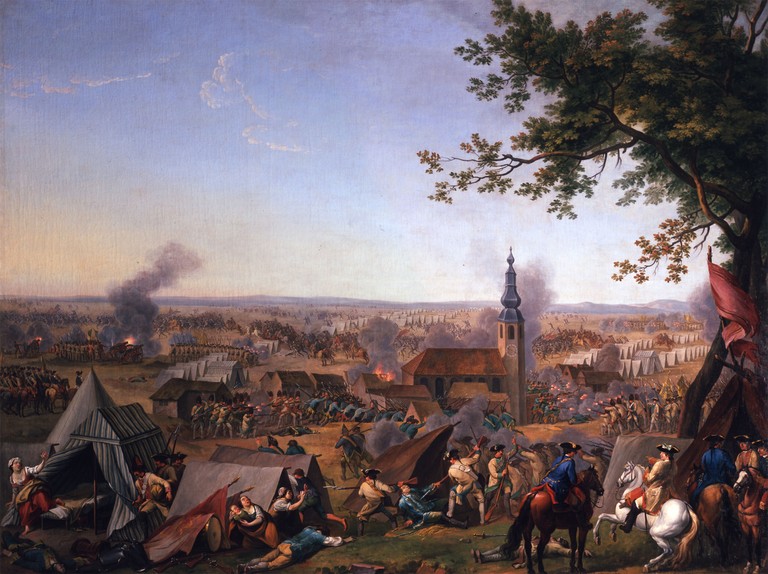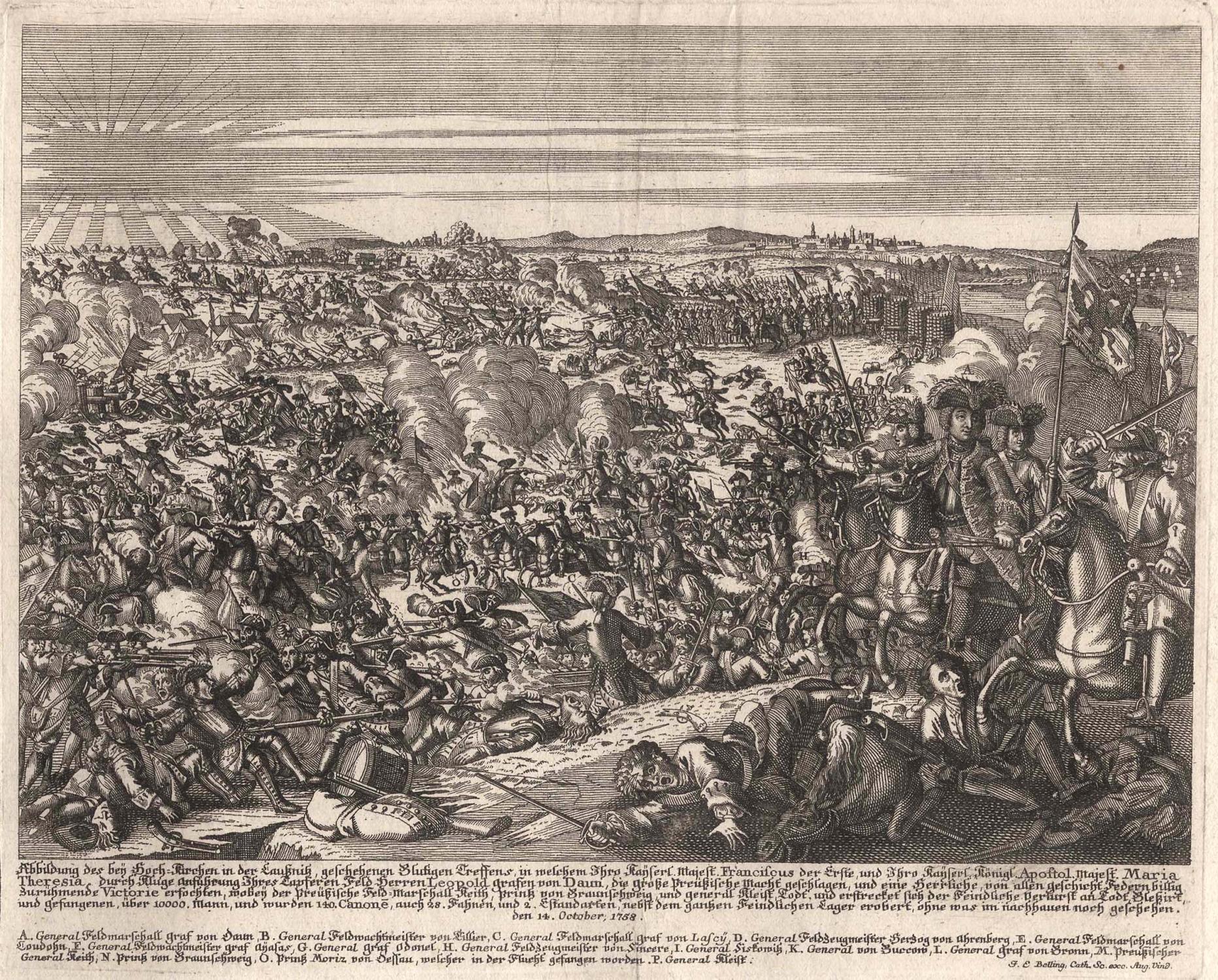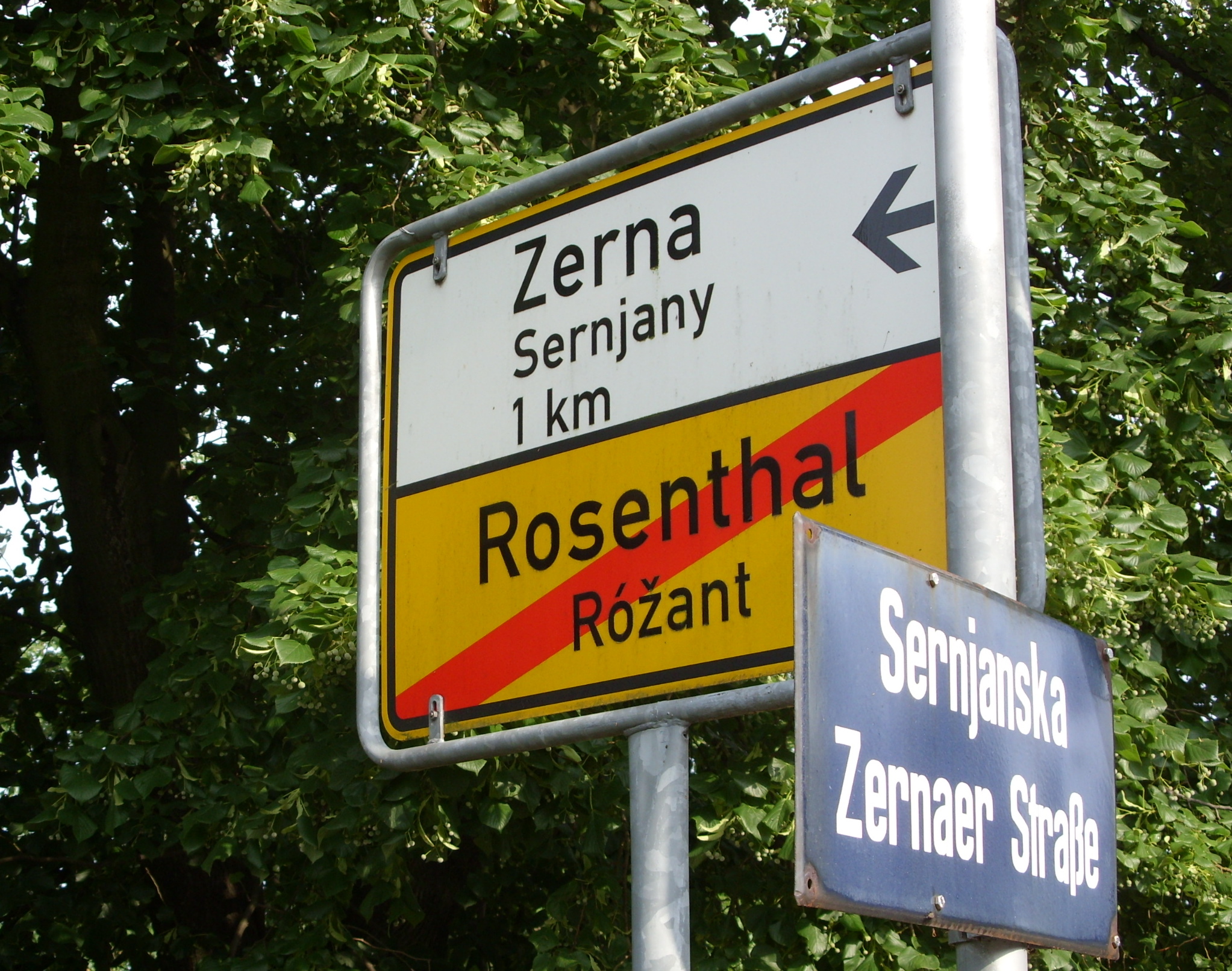|
Hochkirch
Hochkirch (German) or Bukecy (Upper Sorbian) is a municipality in the district of Bautzen, in Saxony, Germany. It is known for the 1758 Battle of Hochkirch, part of the Seven Years' War. The municipality (except Breitendorf) is part of the recognized Sorbian settlement area in Saxony. Upper Sorbian has an official status next to German, all villages bear names in both languages. Geography Hochkirch is located in the historic Upper Lusatia region, about east of the administrative capital Bautzen and northwest of Löbau. Situated within the Lusatian Highlands, it belongs to the settlement area of the Sorbs. History The village of ''Bukovici'' (possibly derived from Upper Sorbian ''buk'': " beech") was first mentioned in a 1222 deed issued by Bishop Bruno II of Meissen; the present German name first appeared in 1368. By the 1635 Peace of Prague, the area passed to the Electorate of Saxony. During the Seven Years' War on 14 October 1758, the Habsburg (Austrian) Imperial Army ... [...More Info...] [...Related Items...] OR: [Wikipedia] [Google] [Baidu] |
Battle Of Hochkirch
The Battle of Hochkirch took place on 14 October 1758, during the Third Silesian War (part of the Seven Years' War). After several weeks of maneuvering for position, an Austrian army of 80,000 commanded by Lieutenant Field Marshal Leopold Josef Graf Daun surprised the Prussian army of 30,000–36,000 commanded by Frederick the Great. The Austrian army overwhelmed the Prussians and forced a general retreat. The battle took place in and around the village of Hochkirch, east of Bautzen, Saxony. Historians generally consider the battle as among Frederick's greatest blunders. Contrary to the advice of his subordinates, he refused to believe that the typically cautious Austrian commander Leopold von Daun would bring his troops into battle. The Austrian force ambushed his army in a pre-dawn attack. Over 30% of Frederick's army was defeated; five generals were killed and he lost his artillery park and a vast quantity of supplies. Although Daun had scored a complete surprise, his atte ... [...More Info...] [...Related Items...] OR: [Wikipedia] [Google] [Baidu] |
James Francis Edward Keith
James Francis Edward Keith (in later years ''Jakob von Keith''; 11 June 1696 – 14 October 1758) was a Scottish soldier and ''Generalfeldmarschall'' of the Royal Prussian Army. As a Jacobite he took part in a failed attempt to restore the Stuart Monarchy to Britain. When this failed, he fled to Europe, living in France, and then Spain. He joined the Spanish and eventually the Russian armies and fought in the Anglo-Spanish War and the Russo-Swedish War. In the latter he participated in the conquest of Finland and became its viceroy. Subsequently, he participated in the ''coup d'état'' that put Elizabeth of Russia on the throne. He subsequently served in the Prussian army under Frederick the Great, where he distinguished himself in several campaigns. He died during the Seven Years' War at the Battle of Hochkirch. He received the Black Eagle Order and is memorialised on the Equestrian statue of Frederick the Great. Early life Keith was born on 11 June 1696 at Inverugie ... [...More Info...] [...Related Items...] OR: [Wikipedia] [Google] [Baidu] |
Seven Years' War
The Seven Years' War (1756–1763) was a global conflict that involved most of the European Great Powers, and was fought primarily in Europe, the Americas, and Asia-Pacific. Other concurrent conflicts include the French and Indian War (1754–1763), the Carnatic Wars and the Anglo-Spanish War (1762–1763). The opposing alliances were led by Great Britain and France respectively, both seeking to establish global pre-eminence at the expense of the other. Along with Spain, France fought Britain both in Europe and overseas with land-based armies and naval forces, while Britain's ally Prussia sought territorial expansion in Europe and consolidation of its power. Long-standing colonial rivalries pitting Britain against France and Spain in North America and the West Indies were fought on a grand scale with consequential results. Prussia sought greater influence in the German states, while Austria wanted to regain Silesia, captured by Prussia in the previous war, and to contain Pruss ... [...More Info...] [...Related Items...] OR: [Wikipedia] [Google] [Baidu] |
Frederick The Great
Frederick II (german: Friedrich II.; 24 January 171217 August 1786) was King in Prussia from 1740 until 1772, and King of Prussia from 1772 until his death in 1786. His most significant accomplishments include his military successes in the Silesian wars, his re-organisation of the Prussian Army, the First Partition of Poland, and his patronage of the arts and the Enlightenment. Frederick was the last Hohenzollern monarch titled King in Prussia, declaring himself King of Prussia after annexing Polish Prussia from the Polish–Lithuanian Commonwealth in 1772. Prussia greatly increased its territories and became a major military power in Europe under his rule. He became known as Frederick the Great (german: links=no, Friedrich der Große) and was nicknamed "Old Fritz" (german: links=no, "Der Alte Fritz"). In his youth, Frederick was more interested in music and philosophy than in the art of war, which led to clashes with his authoritarian father, Frederick William I of Prussia. ... [...More Info...] [...Related Items...] OR: [Wikipedia] [Google] [Baidu] |
Count Leopold Joseph Von Daun
Count Leopold Joseph von Daun (german: Leopold Joseph Maria, Reichsgraf von und zu Daun; 24 September 17055 February 1766), later Prince of Thiano, was an Austrian field marshal of the Imperial Army in the War of the Austrian Succession and Seven Years' War. Early years Leopold Joseph Maria was born at Vienna, the son of Count Wirich Philipp von Daun (1669–1741). The Daun noble family originated from the Rhineland and derived its name from the ancestral seat at Daun south of the High Eifel range. He was intended for the church, but his natural inclination for the army, in which his father and grandfather had been distinguished generals, proved irresistible. In 1718 he served in the War of the Quadruple Alliance in Sicily, in his father's regiment. He had already risen to the rank of ''Oberst'' (Colonel) when he saw further active service in Italy and on the Rhine in the War of the Polish Succession (1734–35). He continued to add to his distinctions in the Turkish War of 1 ... [...More Info...] [...Related Items...] OR: [Wikipedia] [Google] [Baidu] |
Sorbian Settlement Area
hsb, Serbski sydlenski rum, dsb, Serbski sedleński rum, image_map=File:Sorbisches Siedlungsgebiet.png, subdivision_type1=Country, subdivision_name1=Germany, subdivision_type2=State, subdivision_name2=Saxony, subdivision_type3=State, subdivision_name3=Brandenburg The Sorbian settlement area ( dsb, Serbski sedleński rum, hsb, Serbski sydlenski rum, german: Sorbisches Siedlungsgebiet; in Brandenburg officially ''Siedlungsgebiet der Sorben/Wenden'') commonly makes reference to the area in the east of Saxony and the South of Brandenburg in which the West Slavic people of the Sorbs (in Brandenburg also called "Wends") live autochthonously. In colloquial German, it is called Sorbenland (Land of the Sorbs); before 1945 also – sometimes pejoratively – called ''Wendei''. This area was reduced constantly during the centuries due to assimilation, Germanization and strip mining lignite. Additionally, the identification as Sorb is free under federal and state law and cannot be verif ... [...More Info...] [...Related Items...] OR: [Wikipedia] [Google] [Baidu] |
Kito Lorenc
Kito Lorenc (4 March 1938 – 24 September 2017) was a German writer, lyric poet and translator. He was a grandson of the writer and politician Jakub Lorenc-Zalěski. Lorenc attended the Sorbian boarding high school in Cottbus from 1952 to 1956 and majored in Slavic studies in Leipzig from 1956 to 1961. He was an employee at the Institute for Sorbian People Research in Bautzen between 1961 and 1972. From 1972 until 1979, he worked as a dramaturge at the State Ensemble for Sorbian People's Culture. Kito Lorenc was a member of the Sächsischen Akademie der Künste and lived as a freelance writer in Wuischke by Hochkirch. Works * "''Nowe časy - nowe kwasy''" (New Times - New Weddings), Poems, VEB Verlag Domowina, 1962 * "''Swĕtło, prawda, swobodnosć''" (Light, Justice and Freedom), (Anthology of Sorbian Poets, Editor) VEB Verlag Domowina, 1963 * Mina Witkojc "''Po pućach časnikarki''", Translation in Upper Sorbian, VEB Verlag Domowina 1964 * Handrij Zejler "''Serbske fabule ... [...More Info...] [...Related Items...] OR: [Wikipedia] [Google] [Baidu] |
Bautzen (district)
The district of Bautzen (german: Landkreis Bautzen, hsb, Wokrjes Budyšin) is a district in the state of Saxony in Germany. Its largest towns are Bautzen, Bischofswerda, Kamenz, Hoyerswerda and Radeberg. It is the biggest district in Saxony by area, and a member of the Neisse Euroregion. It is bordered to the south by the Czech Republic. Clockwise, it also borders the district of Sächsische Schweiz-Osterzgebirge, the district-free city of Dresden, the district of Meißen, the state of Brandenburg, and the Görlitz district. History Historically, most of Upper Lusatia belonged to Bohemia. After the end of the Thirty Years' War, it became a part of Saxony. Only the small town of Schirgiswalde remained Bohemian until 1809. The district was established in 1994 by merging the former districts of Bautzen and Bischofswerda. The district of Kamenz and the district-free city of Hoyerswerda were merged into the district in August 2008. Geography The district of Bautzen is part ... [...More Info...] [...Related Items...] OR: [Wikipedia] [Google] [Baidu] |
Prussian Army
The Royal Prussian Army (1701–1919, german: Königlich Preußische Armee) served as the army of the Kingdom of Prussia. It became vital to the development of Brandenburg-Prussia as a European power. The Prussian Army had its roots in the core mercenary forces of Brandenburg during the Thirty Years' War of 1618–1648. Elector Frederick William developed it into a viable standing army, while King Frederick William I of Prussia dramatically increased its size and improved its doctrines. King Frederick the Great, a formidable battle commander, led the disciplined Prussian troops to victory during the 18th-century Silesian Wars and greatly increased the prestige of the Kingdom of Prussia. The army had become outdated by the beginning of the Napoleonic Wars, and France defeated Prussia in the War of the Fourth Coalition in 1806. However, under the leadership of Gerhard von Scharnhorst, Prussian reformers began modernizing the Prussian Army, which contributed greatly to the defea ... [...More Info...] [...Related Items...] OR: [Wikipedia] [Google] [Baidu] |
Electorate Of Saxony
The Electorate of Saxony, also known as Electoral Saxony (German: or ), was a territory of the Holy Roman Empire from 1356–1806. It was centered around the cities of Dresden, Leipzig and Chemnitz. In the Golden Bull of 1356, Emperor Charles IV designated the Duchy of Saxe-Wittenberg an electorate, a territory whose ruler was one of the prince-electors who chose the Holy Roman emperor. After the extinction of the male Saxe-Wittenberg line of the House of Ascania in 1422, the duchy and the electorate passed to the House of Wettin. The electoral privilege was tied only to the Electoral Circle, specifically the territory of the former Duchy of Saxe-Wittenberg. In the 1485 Treaty of Leipzig, the Wettin noble house was divided between the sons of Elector Frederick II into the Ernestine and Albertine lines, with the electoral district going to the Ernestines. In 1547, when the Ernestine elector John Frederick I was defeated in the Schmalkaldic War, the electoral district and el ... [...More Info...] [...Related Items...] OR: [Wikipedia] [Google] [Baidu] |
The Left (Germany)
The Left (german: Die Linke; stylised as and in its logo as ), commonly referred to as the Left Party (german: Die Linkspartei, links=no ), is a democratic socialist political party in Germany. The party was founded in 2007 as the result of the merger of the Party of Democratic Socialism (PDS) and Labour and Social Justice – The Electoral Alternative. Through the PDS, the party is the direct descendant of the Marxist–Leninist ruling party of the former East Germany, the Socialist Unity Party of Germany. Since 2022, The Left's co-chairpersons have been Janine Wissler and Martin Schirdewan. The party holds 39 seats out of 736 in the Bundestag, the federal legislature of Germany, having won 4.9% of votes cast in the 2021 German federal election. Its parliamentary group is the smallest of six in the Bundestag, and is headed by parliamentary co-leaders Amira Mohamed Ali and Dietmar Bartsch. The Left is represented in nine of Germany's sixteen state legislatures, including all ... [...More Info...] [...Related Items...] OR: [Wikipedia] [Google] [Baidu] |
Christian Democratic Union Of Germany
The Christian Democratic Union of Germany (german: link=no, Christlich Demokratische Union Deutschlands ; CDU ) is a Christian democratic and liberal conservative political party in Germany. It is the major catch-all party of the centre-right in German politics. Friedrich Merz has been federal chairman of the CDU since 31 January 2022. The CDU is the second largest party in the Bundestag, the German federal legislature, with 152 out of 736 seats, having won 18.9% of votes in the 2021 federal election. It forms the CDU/CSU Bundestag faction, also known as the Union, with its Bavarian counterpart, the Christian Social Union in Bavaria (CSU). The group's parliamentary leader is also Friedrich Merz. Founded in 1945 as an interdenominational Christian party, the CDU effectively succeeded the pre-war Catholic Centre Party, with many former members joining the party, including its first leader Konrad Adenauer. The party also included politicians of other backgrounds, including libe ... [...More Info...] [...Related Items...] OR: [Wikipedia] [Google] [Baidu] |





